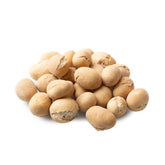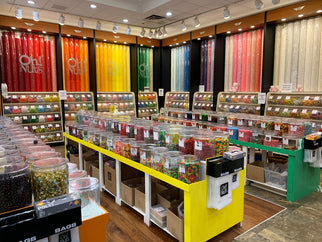Collection:
Peanuts
(44 products)-
Select an option
1 LB Bag-$4.19
5 LB Bag-$19.45
25 LB Case-$77.37
Select an option
1 LB Bag-$4.19
5 LB Bag-$19.45
25 LB Case-$77.37
Roasted Salted Peanuts
-
Select an option
1 LB Bag-$4.89
5 LB Bag-$22.19
25 LB Case-$90.49
Select an option
1 LB Bag-$4.89
5 LB Bag-$22.19
25 LB Case-$90.49
Roasted Unsalted Peanuts
-
Select an option
1 LB Bag-$4.99
5 LB Bag-$20.97
30 LB Case-$98.84
Select an option
1 LB Bag-$4.99
5 LB Bag-$20.97
30 LB Case-$98.84
Toffee Glazed Peanuts
-
Select an option
1 LB Bag-$5.39
20 LB Case-$82.39
Select an option
1 LB Bag-$5.39
20 LB Case-$82.39
Roasted Unsalted Peanuts in Shell
Sold out -
Select an option
1 LB Bag-$8.49
26.4 LB Case-$4.99
Select an option
1 LB Bag-$8.49
26.4 LB Case-$4.99
Israeli Kabukim Peanuts
-
Select an option
1 LB Bag-$3.49
5 LB Bag-$18.45
30 LB Case-$82.99
Select an option
1 LB Bag-$3.49
$3.99 Sale5 LB Bag-$18.45
30 LB Case-$82.99
$89.79 SaleRaw Blanched Peanuts
Sold out -
Select an option
1 LB Bag-$5.99
15 Lb Case-$67.49
Select an option
1 LB Bag-$5.99
15 Lb Case-$67.49
Gourmet Peanut Brittle
-
Select an option
1 LB Bag-$3.99
5 LB Bag-$14.97
30 LB Case-$77.79
Select an option
1 LB Bag-$3.99
5 LB Bag-$14.97
30 LB Case-$77.79
Raw Redskin Peanuts
-
Select an option
1 LB Bag-$18.99
10 LB Case-$149.19
Select an option
1 LB Bag-$18.99
10 LB Case-$149.19
Dark Chocolate Covered Peanuts
-
Select an option
1 LB Box-$10.19
10 LB Case-$75.79
Select an option
1 LB Box-$10.19
10 LB Case-$75.79
Peanut Brittle Cluster Crunch
-
Select an option
1 LB Bag-$5.89
5 LB Bag-$26.69
25 LB Case-$108.89
Select an option
1 LB Bag-$5.89
5 LB Bag-$26.69
25 LB Case-$108.89
Sesame Honey Glazed Peanuts
-
Select an option
1 LB Bag-$5.49
5 LB Bag-$23.79
20 LB Case-$82.79
Select an option
1 LB Bag-$5.49
5 LB Bag-$23.79
20 LB Case-$82.79
French Burnt Peanuts
Sold out -
Select an option
12CT-$11.89
60CT Box-$53.69
120CT Case-$87.99
Select an option
12CT-$11.89
60CT Box-$53.69
120CT Case-$87.99
Honey Glazed Roasted Peanuts Snack Packs
-
Select an option
1 LB Bag-$8.49
26.4 LB Box-$166.79
Select an option
1 LB Bag-$8.49
26.4 LB Box-$166.79
Israeli Sesame Kabukim Peanuts
-
Select an option
12CT-$19.99
60CT Box-$75.29
120CT Case-$138.49
Select an option
12CT-$19.99
60CT Box-$75.29
120CT Case-$138.49
Dark Chocolate Covered Peanuts Snack Packs
-
Select an option
1 LB Bag-$4.99
25 LB Case-$89.99
Select an option
1 LB Bag-$4.99
25 LB Case-$89.99
Dry Roasted Salted Redskin Peanuts
Sold out -
Select an option
1 LB Bag-$4.39
30 LB Case-$89.79
Select an option
1 LB Bag-$4.39
30 LB Case-$89.79
Spicy Peanuts
-
Select an option
1 LB Bag-$4.99
30 LB Case-$98.84
Select an option
1 LB Bag-$4.99
30 LB Case-$98.84
Honey Roasted Peanuts
Sold out -
Select an option
1 LB Bag-$5.09
5 LB Bag-$22.99
25 LB Case-$94.29
Select an option
1 LB Bag-$5.09
5 LB Bag-$22.99
25 LB Case-$94.29
Boston Baked Beans Peanuts
Sold out -
Select an option
1 LB Bag-$5.39
15 Lb Case-$59.99
Select an option
1 LB Bag-$5.39
15 Lb Case-$59.99
$67.39 SalePeanut Brittle Bites
Sold out -
Select an option
1 LB Bag-$6.79
5 LB Bag-$29.19
12 LB Case-$57.29
Select an option
1 LB Bag-$6.79
5 LB Bag-$29.19
12 LB Case-$57.29
Cinnamon Peanuts
-
Select an option
1 LB Bag-$6.19
22 LB Case-$100.99
Select an option
1 LB Bag-$6.19
22 LB Case-$100.99
Seaweed Peanuts
Sold out -
Select an option
1 LB Bag-$5.69
22 LB Case-$94.47
Select an option
1 LB Bag-$5.69
22 LB Case-$94.47
Japanese Peanuts
-
Select an option
8 oz Box-$5.99
5 LB Case-$51.49
Select an option
8 oz Box-$5.99
5 LB Case-$51.49
Dark Chocolate Peanut Bark
-
Select an option
1 LB Bag-$5.29
22 LB Case-$84.79
Select an option
1 LB Bag-$5.29
22 LB Case-$84.79
Cajun Peanuts
-
Select an option
1 LB Bag-$4.55
30 LB Case-$122.79
Select an option
1 LB Bag-$4.55
$5.69 Sale30 LB Case-$122.79
Sugar Toasted Peanuts
Sale -
Select an option
1 LB Bag-$4.99
25 LB Case-$82.20
Select an option
1 LB Bag-$4.99
25 LB Case-$82.20
Dry Roasted Unsalted Redskin Peanuts
-
Select an option
1 LB Bag-$13.99
6.6 LB Case-$87.69
Select an option
1 LB Bag-$13.99
6.6 LB Case-$87.69
Halva Coated Peanuts
-
Select an option
1 LB Bag-$6.39
30 LB Case-$137.79
Select an option
1 LB Bag-$6.39
30 LB Case-$137.79
Chick-O-Sticks Peanut Coconut Bites
Sold out -
Select an option
1 LB Bag-$8.19
22 LB Case-$149.99
Select an option
1 LB Bag-$8.19
$10.39 Sale22 LB Case-$149.99
$170.29 SaleWasabi Peanuts
Sale -
Select an option
1 LB Bag-$5.59
33 Lb Case-$172.69
Select an option
1 LB Bag-$5.59
$7.29 Sale33 Lb Case-$172.69
American Style Coated Peanuts
Sold out

![[PRIMARY_IMAGE]](http://ohnuts.com/cdn/shop/files/1746650030497_0_qqrpp6.jpg?v=1746650032&width=165)
![[PRIMARY_IMAGE]](http://ohnuts.com/cdn/shop/files/1746652383167_0_kx0ov1.jpg?v=1746652385&width=165)
![[PRIMARY_IMAGE]](http://ohnuts.com/cdn/shop/files/1746717529746_0_fpujbv.jpg?v=1746717533&width=165)
![[PRIMARY_IMAGE]](http://ohnuts.com/cdn/shop/files/1746650720158_0_k9otjv.jpg?v=1746650723&width=165)

![[PRIMARY_IMAGE]](http://ohnuts.com/cdn/shop/files/1746651422041_0_es8667.jpg?v=1746651424&width=165)
![[PRIMARY_IMAGE]](http://ohnuts.com/cdn/shop/files/1746717210708_0_243ood.jpg?v=1746717215&width=165)
![[PRIMARY_IMAGE]](http://ohnuts.com/cdn/shop/files/1746720253216_0_6uyta6.jpg?v=1746720257&width=165)
![[PRIMARY_IMAGE]](http://ohnuts.com/cdn/shop/files/1746650310652_0_bpn5ff.jpg?v=1746650313&width=165)
![[PRIMARY_IMAGE]](http://ohnuts.com/cdn/shop/files/1746650390210_0_an4o4g.jpg?v=1746650392&width=165)
![[PRIMARY_IMAGE]](http://ohnuts.com/cdn/shop/files/1746651627516_0_suxsc7.jpg?v=1746651631&width=165)
![[PRIMARY_IMAGE]](http://ohnuts.com/cdn/shop/files/1746717296599_0_ps8fxc.jpg?v=1746717300&width=165)
![[PRIMARY_IMAGE]](http://ohnuts.com/cdn/shop/files/1746722396740_0_mm24ew.jpg?v=1746722399&width=165)
![[PRIMARY_IMAGE]](http://ohnuts.com/cdn/shop/files/1746717315343_0_ez0j8l.jpg?v=1746717319&width=165)
![[PRIMARY_IMAGE]](http://ohnuts.com/cdn/shop/files/1746680081109_0_md5wo4.jpg?v=1746680210&width=165)
![[PRIMARY_IMAGE]](http://ohnuts.com/cdn/shop/files/1746651388676_0_6fsrb5.jpg?v=1746651391&width=165)
![[PRIMARY_IMAGE]](http://ohnuts.com/cdn/shop/files/1746720413997_0_59nvtn.jpg?v=1746720419&width=165)
![[PRIMARY_IMAGE]](http://ohnuts.com/cdn/shop/files/1746718822747_0_udzb5k.jpg?v=1746718826&width=165)
![[PRIMARY_IMAGE]](http://ohnuts.com/cdn/shop/files/1746717301606_0_m38676.jpg?v=1746717305&width=165)
![[PRIMARY_IMAGE]](http://ohnuts.com/cdn/shop/files/1746717216326_0_u51r6j.jpg?v=1746717220&width=165)
![[PRIMARY_IMAGE]](http://ohnuts.com/cdn/shop/files/1746675306396_0_2lr4ck.jpg?v=1746675337&width=165)
![[PRIMARY_IMAGE]](http://ohnuts.com/cdn/shop/files/1746718844857_0_zabj2n.jpg?v=1746718849&width=165)
![[PRIMARY_IMAGE]](http://ohnuts.com/cdn/shop/files/1746720366277_0_3xf9gr.jpg?v=1746720370&width=165)
![[PRIMARY_IMAGE]](http://ohnuts.com/cdn/shop/files/1746687902061_0_ycsaa1.jpg?v=1746687930&width=165)
![[PRIMARY_IMAGE]](http://ohnuts.com/cdn/shop/files/1746718834495_0_kvs7m6.jpg?v=1746718839&width=165)
![[PRIMARY_IMAGE]](http://ohnuts.com/cdn/shop/files/1746649980611_0_v9p5qa.jpg?v=1746649983&width=165)
![[PRIMARY_IMAGE]](http://ohnuts.com/cdn/shop/files/1746674400191_0_ea6lnc.jpg?v=1746674415&width=165)
![[PRIMARY_IMAGE]](http://ohnuts.com/cdn/shop/files/1746725220928_0_pmkfcu.jpg?v=1746725225&width=165)
![[PRIMARY_IMAGE]](http://ohnuts.com/cdn/shop/files/1746721897601_0_0ie3ww.jpg?v=1746721900&width=165)
![[PRIMARY_IMAGE]](http://ohnuts.com/cdn/shop/files/1746710562624_0_yq9cbp.jpg?v=1746710572&width=165)
![[PRIMARY_IMAGE]](http://ohnuts.com/cdn/shop/files/1746718839712_0_42zerr.jpg?v=1746718843&width=165)
![[PRIMARY_IMAGE]](http://ohnuts.com/cdn/shop/files/1746720158883_0_yijm7u.jpg?v=1746720163&width=165)




